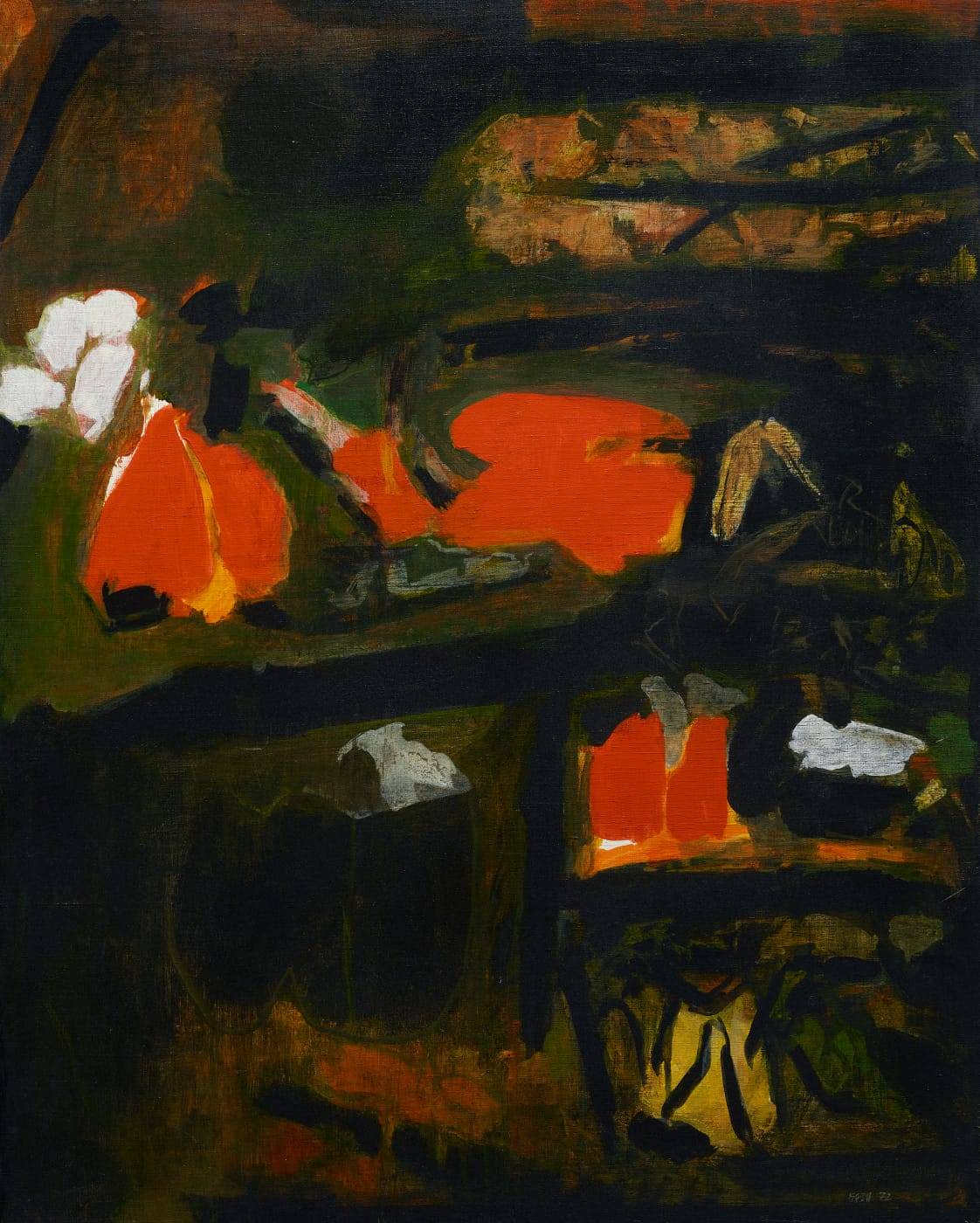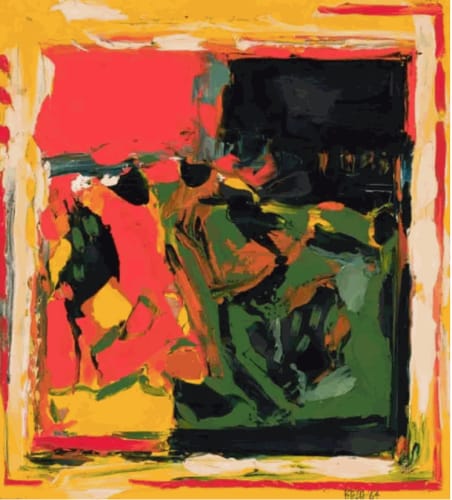The installation views of Sayed Haider Raza’s celebration in London speak about the beauty of the past and the integrity needed to prove provenance in the works of a modern master. Grosvenor Gallery in London presents paintings from 1964 – 2003.
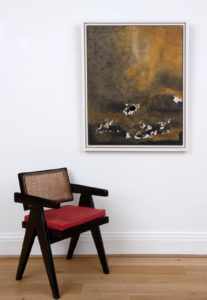
Raza’s works from the 1960s are a feast for the senses. They uphold his love for the landscape and his sensitivity towards atmospherics in nature. To study these works closely is to stand in silence and marvel at the reverence of rippled nuances that viewers in London will evince at this historical exhibition.
Untitled Maisons 1963
Untitled (Maisons), 1963 is an oil on canvas that belongs to a Private collection, in France; the notes say
Versailles Encheres-Perrin, Royere, Lajeunesse, Tableaux Abstraits et Contemporains, and was sold on 17 December, 2006.It will feature in the SH Raza, Catalogue Raisonné, Volume I (1958—1971).A number of works stand out in this suite at Grosvenor which is known for its unveilings of Indian modern masters.
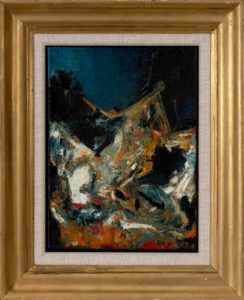
The orchestration of colour is what greets your eyes as you espie a sensorial signature created against the ebony shades of night time.The current work painted in 1963 is typical of this period; heavy impasto and architectural elements appear within an abstracted lyrical landscape, ‘ Be it village, town or church, the world according to Raza was aflame. It was being forged anew through the crucible of recollection—baptized through fire.’wrote Geeti Sen in Bindu.
Composition 1,1964
The second work titled Composition I, 1964 belonging to Galerie Dresdnere and Arthur Lunar, Transports Internationaux is a riot of colour tones and flaming energies created as an acrylic on masonite.The Grosvenor notes state that Simon Dresdnere established his eponymous gallery in Montreal in 1957. Shortly beforehand Dresdnere initiated
a friendship with Parisian gallery owner Lara Vincy, who was at the time working with Raza. Raza’s work was first included in a group exhibition at Dresdnere in May 1958.
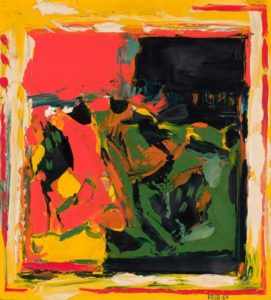
There was strong demand for Raza’s work, and the gallery inventory records show that 27 paintings were shipped to Canada in November that year, 26 of which were rapidly sold to local collectors. Raza enjoyed two successful solo-exhibitions there in 1959 and 1962, after which the gallery moved to Toronto. The gallery continued to work with Raza until around 1968.
The most important quality in this painting is its flashback of memories and history as it echoes the fact that Raza created it with the palette derived from Raza’s continued interest in Rajput miniature paintings.
Untitled, 1965
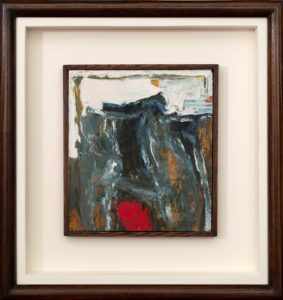
The third work in the suite is an Untitled 1965 work that brings back Raza’s words in an interview to this critic in 2015 . “ It was the search for the intangible that always drove my thirst for the panchatatva or five elements. In my quest to create the intangible in the 1960s , I tried to find ways to capture the moods of places along with an unconscious preoccupation of evoking the essence of moods within the web of the visual dynamics of darkness and light. Within the change of seasons and the delight of the elements of nature my work deepened into gestural tones and expression.”
Le Ciel, 1966 and Composition, 1967
Smoky embers and autumnal accents come to the fore in Le Ciel , 1966, a seminal work that has been sourced from Paris. In the aftermath of moving to Paris Raza studied French masters and began to use colour as a tool of construction, switching from gouache and watercolour to more tactile oil-based pigments. Soon, however, colour overtook construction, and Raza’s landscapes of the French countryside became less about tangible representation and more about the mood they evoked in the artist. This ochre toned wonder is about a slow creeping of twilight, and the sunset falling through thick swathes of vivid done in staccato strokes.The second work in the same mood belonging to 1967 also mirrors the
evanescent echo
.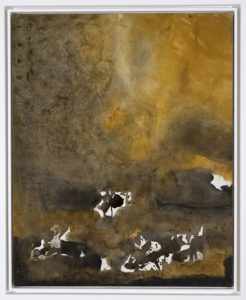
In the Composition of the second the pictorial space in Raza’s painting is more structured, exploring the play of light and colour in nature’s shadows of nightfall. We see that in the 1960s he was playing with different strokes of incandescent aura. Sometimes soft and suffused sometimes filled with darkened strokes of forest trees,this stylistic turn was reinforced in 1962, when Raza spent a summer teaching at the University of California, Berkeley. During his time in the United States. Raza was deeply impacted by the work of Abstract Expressionists Sam Francis, Hans Hoffman and Mark Rothko.
Speaking about this encounter, to this critic in the year of his 85th birthday in an interview conducted over 3 days , he noted, “ Rothko’s work opened up lots of interesting associations for me. It was so different from the insipid realism of the European School. It was like a door that opened to another interior vision. Yes, I felt that I was awakening to the music of another forest, one of subliminal energy. Rothko’s works brought back the images of japmala, where the repetition of a word continues till you achieve a state of elated consciousness. Rothko’s works made me understand the feel for spatial perception.” (Artist statement, Raza: Celebrating 85 Years, Interview with Uma Nair , Aryan Art Gallery exhibition catalogue, New Delhi, 2007 )
Costapoglia , 1972
Riveting and filled with resonance of the conversations that happen in the eventide of the day, this work Costapoglia brings back the words of the French critic Jean-Dominique Rey, who wrote
introduction note for the 1975 exhibition at Galleria Matuzia.“ Sayed Haider Raza, the Indian who became Parisian who, without ignoring anything of modern painting, will not have cut any of his deep roots but will have thrown a bridge between two worlds, two traditions… But during this same journey, he will have acquired the means to express with force and penetration this bewitchment and this terror of the native forest, the alternations and marriages of the elements whose weft and warp, dark and luminous, create a space which, in itself, is a signature and a sign of recognition. “Let the path remain unknown and let the soul remain alone” says a Hindu proverb that Raza inscribed on one of his paintings. No doubt we have here one of the secrets of creation and, in any case, the key to this work.”
